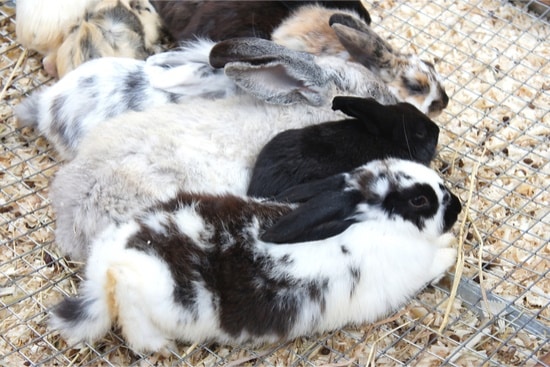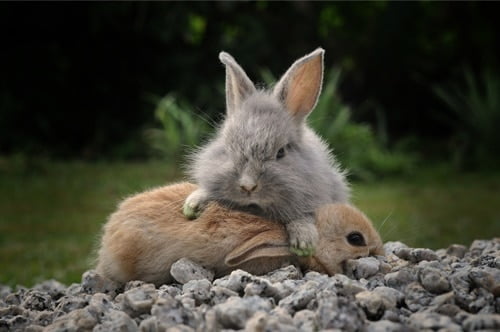Rabbits have moods and experience changes in behavior. They have good memories and often remember their fights. You’ve probably noticed that some rabbits don’t fight at all for years and start fighting all of a sudden for no obvious reason.
Rabbits fighting to the death is most likely to happen between two unneutered male rabbits. Deadly fights between two female rabbits are far less common. Factors that increase the risk of fights include, one rabbit being a larger breed, one rabbit being younger, or one rabbit being older.
In the wild, a buck rabbit (male) will fight for the right to breed with a doe (female). This ensures that only the strongest and healthiest bucks will produce the next generation.
Why Rabbits Attack Each Other
| Cause | Solution | |
|---|---|---|
| Male vs. Male | – Not being neutered – Territoriality – Boredom – One breed is larger than the other – Competition for food | – Neuter – Include toys, tunnels and hiding places – Have a set feeding schedule – Separate the rabbits if fighting continues |
| Female vs. Female | – One breed is larger than the other – One rabbit is older than the other – One rabbit is more dominant – Competition for food | – Do not house rabbits of different sizes together – Have a set feeding schedule |
| Female vs. Male | – Female isn’t interested in mating – One breed is larger than the other – Competition for food | – Separate the two rabbit – Have a set feeding schedule |
Two Unneutered Males Fighting to the Death
Rabbits sexually mature between 16 and 24 weeks. Smaller breeds mature earlier than larger ones. At 10 weeks, if two males are housed together, they’re likely to fight.
In the wild, European rabbits tend to live in large groups. One dominant buck may share his territory with many does and subordinate rabbit bucks. This is based on a burrow system with many entrances (a warren), according to Applied Animal Behavior Science.
When a rabbit buck reaches sexual maturity, he becomes more aggressive and territorial due to hormonal reasons and unsatisfied sexual frustrations. In the wild, a buck will fight with other bucks for the right to breed with female rabbits.
The urge to fight occurs as a result of an increase in testosterone in bucks, along with an interest in females. These fights can continue until the winner ends up with a doe or a group of does. Some battles can go on until one rabbit dies. It’s not unusual to see at least one rabbit getting injured.
Fighting for the right to breed is one way to ensure that the healthiest and strongest bucks are responsible for the next generation.
Territorial Behavior in Rabbits
Territorial behavior may increase during certain times of the year, especially during the main breeding season for a rabbit, between January and August in the northern hemisphere.
Rabbits are also likely to fight for feeding grounds, especially if there isn’t abundant food.
Although rabbits don’t have large territories, they are known to defend the territory they have with vigor. Unwanted aggressive behaviors between rabbits often include mounting, circling, and biting.
Spaying and neutering your rabbits can drastically reduce aggressiveness in intact rabbits. In most cases, once the social hierarchy is established, fights become much rarer. As long as the rabbits know their place and yield to others that are ranked higher, things go smoothly.
One major reason breeders place a buck in the does cage for breeding is to avoid fights. If a doe is placed inside a cage with more than one buck, there’s a high risk for a deadly battle. This is especially the case if the buck thinks he has to defend his territory.
Two Female Rabbit Fighting to the Death
It’s more common to see male rabbits fighting each other to the death than two females fighting.
According to Applied Animal Behavior Science, females are not territorial and are often found sharing their home space with many other does. Although rare, female rabbits can fight to the death.
Female rabbits are more likely to fight if one has an advantage over the other. For example, a dominant female rabbit may be of a larger breed or older than the one she is threatening. Her opponent may also be at a significant disadvantage if she is too old and weak.
Sudden introductions can also provoke fights between does.
If your rabbits are fighting, separate them for their own safety. Take steps to help mend their bond. If your rabbit does continue to fight, it may be time to separate them permanently.
Male Rabbit Fighting Female Rabbit to the Death
Occasionally, a doe may fight with a buck. For example, if a buck wants to breed and the female rabbit isn’t receptive to breeding yet, she may show signs of aggression. In such cases, fights aren’t often serious and are less likely to cause serious damage.
If you notice two females fighting, or a male and female fighting, do not ignore the issue. With any gender, it is critical that you look out for signs of hostility.
Boredom
Your rabbits must have a mentally and physically stimulating environment, with plenty of tunnels, boxes, hiding places, and toys.
Rabbits that don’t have enough space to hide from each other are likely to get frustrated and show aggression towards their cage mates.
Food
Fighting can be triggered if food is scarce or if one rabbit is greedier than the other.
Rabbits are creatures of habit. Any changes in their routine, such as you going away and changing their feeding plan can stimulate aggression.
Owners who leave their pets, often report returning from their vacation to a cage full of ripped fur and unhappy rabbits.
Late Introductions
Even though rabbit bucks have large home ranges, there can be large overlaps in space with other rabbits of both genders. Behavioral Processes found that rabbits may not display any behavioral response to the scent of a neighbor, but often discriminate against the scent of a stranger.
The best time to introduce rabbits is in the first few months of life before they reach sexual maturity. During this time, spaying and neutering is a must to prevent unwanted aggressiveness. Rabbits that are introduced later in life are likely to fight.
When you bring a new rabbit home, it is essential that you introduce it gradually to your existing rabbits. Rabbits are among the most territorial mammals. Skipping a slow introduction can result in major fights and possibly even death in one of the rabbits.
This is especially true if the newcomer is a baby rabbit. A young rabbit is less capable of defending itself against stronger adult rabbits.
Rabbits must be given a chance to bond properly. Abrupt introductions can be stressful to rabbits and can lead to irreversible, damaging results.

Are My Rabbits Fighting Or Playing?
Even bonded rabbits frequently have scuffles and disputes (tiffs.)
Of course, a normal tiff is entirely different from a fight, especially one that leads to death. When bonded rabbits fight, rebonding can be highly challenging.
Rabbits have sharp memories and are likely to remember their fights. Some rabbit owners report having no problems at all for years, and all of a sudden havoc erupts.
Paying close attention to your rabbit’s behaviors will help you identify whether your bonded pets are having a tiff or a fight. In most cases, acceptable tiffs do not require human intervention.
In most cases, it’s best to stay out of the tiff. Fighting is different, however. When you see unacceptable signs of aggression that may harm one or both of the fighting bunnies within a short timeframe, you must intervene immediately.
Acceptable Behavior in Rabbits
The following are some accepted tiff behaviors in rabbits:
- Lunging, light boxing, and retreating. As long as no pursuit follows, such behaviors are not a cause for concern. They’re simply bunny bluffs, or one rabbit giving the other a warning. They are a part of nonverbal body language communication that exhibits displeasure.
- Mounting. This one is often misunderstood because it can have dual meanings. Mounting or humping is a common show of dominance in rabbits. However, it’s also a sign that one rabbit is accepting the other as a partner.
- Nipping. Any nipping that does not result in a full bite does not require intervention. Nipping is a body language used for warning and often means “back off” or “stop it.”
- Nose bumping. This is typically used to get a partner’s attention.
- Following each other in a room. A submissive rabbit will often follow an alpha rabbit across the room during play. This is common in bonded pairs and groups of bonded rabbits. Make sure that your rabbits are playing and not actively chasing each other.
Unacceptable Behavior in Rabbits
Sometimes what appears to be a harmless quarrel between two rabbits, may lead to a potentially life-threatening fight. Signs to look out for include:
- Chasing. If one rabbit is pursuing another rabbit with intention, separate the two immediately.
- Bites. Although rabbit bites don’t always lead to bleeding, most often they do. Their fur might be missing in the bitten area, with teeth marks on the skin and even a tear. This doesn’t only cause severe damage; it can also increase a rabbit’s risk of infection.
- Rough mounting or persistent mounting. Mounting isn’t friendly if a submissive rabbit is stressed, is getting bitten, starts thrashing or tries to escape.
- Circling. This is when one rabbit chases another in a circle, persistently going round and round. It’s often called a “tornado.”
- Grunting. A growl-type noise indicates serious displeasure and is often a sign of an angry or aggressive rabbit.
- Any other rough behavior that may lead to stress or injury.
What To Do If Rabbits Start Fighting
You walk into a room and find your bonded rabbits fighting. What’s normally a calm and friendly environment has become a bunny battleground.
One rabbit is attempting to flee, while there other tries to get a grip of the opponent’s back end. They’re in a full-circle chase or the dreaded tornado.
Here’s what you need to do if you find your rabbits fighting.
Don’t Ignore the Fight
Many rabbit owners believe that two perfectly bonded rabbits will never harm each other. They mistake a fight for play or a tiff. However, this isn’t always true.
Fighting rabbits can and usually do cause severe harm to one another. Not only can this result in physical trauma in your rabbits, but it can lead to high vet bills as well.
You’ll know that your rabbits are fighting if you notice fur on the ground, your rabbits actively chasing each other or biting to inflict injury.
Make a Loud Noise
You can easily stop a rabbit fight by clapping your hands together loudly and saying “eeeeeeek” in a high-pitched voice. Having a whistle at hand also does the trick.
Creating a high-pitched sound causes enough stress to disrupt your rabbits. If you have had bonded rabbits for a while, you’ll know that rabbits cling to one another when they are scared or stressed.
Stress bonding is a common technique used by owners to rebond their bunnies. It’s a theory that’s also used when taking unbonded rabbits together in a car ride.
However, understand that if your rabbits are in a serious fight, making a loud noise may not be enough to disturb them.
Separate Them Immediately
If making a loud noise doesn’t work, try to separate the rabbits yourself. Wrap your hand in a towel to protect it from scratches and bites while you break up the fight.
Rabbits are vicious when they’re fighting, with many of them fighting each other to the death. It’s always smart to err on the side of caution, no matter how bonded you are with your bunnies.

Assess Your Rabbits for Injuries
A rabbit’s thick fur can make this difficult, but be careful and do your best. Watch how your rabbit’s hop. Does it look normal, or is there a limp? Check the legs, hind area, face, jaws, eyes, and ears.
If you notice any injury or tear that requires medical attention, call your veterinarian as soon as possible. While assessing your rabbit’s injuries, make sure your rabbit has settled down and is calm. Pay attention to any area your rabbit grooms. Chances are it will lick the area that is hurt.
Keep Your Rabbits Separated
Keep your bunnies separated for a few hours or more as needed. Rabbits remember fights, particularly the bad ones. Fights that last just a few seconds can break up a close friendship because of a rabbit’s ability to remember its fights.
Never force rabbits to stay in the same space after a fight. It’s unlikely that they will bond again and may even have another big fight.
Separate Rabbits with Fencing
Pet fences or large housing crates set up in a way where the rabbits can still touch and have contact but cannot fight is perfect to help them settle down.
If the grudge is severe, they may continue to fight through the gaps in the pet fence or crate. If fighting through the fence persists, you may need to keep one rabbit in another space.
You can create a temporary block over your pet fencing by draping a towel over the fence. This will prevent them from seeing each other. Once your rabbits cool down, remove the towel and allow them to interact through the fence again. Pay close attention to make sure they don’t start fighting.
If your rabbits were previously bonded, chances are they will want to be together eventually. Sometimes you can separate them completely and still expect your rabbits to repair their bond within the same day.
Rabbits are good at remembering their fights and holding grudges for prolonged periods. A fight can replace good memories of a rabbit’s partner with bad ones.
Always take steps to reduce and if possible, prevent serious fights. If the fighting continues, rabbits that were once bonded will behave as if they were never bonded at all, causing stress to the owner.
What To Do If Rabbits Injure Each Other While Fighting
Separate the injured rabbit immediately to prevent additional harm to your bunnies. If the injury is severe and requires medical intervention, take your rabbit to a vet.
Rabbits that inflict severe injuries upon each other must be permanently separated. This is because, at this point, it may be close to impossible to rebond them.
It’s always important to be careful while mixing rabbits of different ages. Younger rabbits are at a much higher risk of being harmed and injured by older and more domineering rabbits. The same goes for rabbits of different sizes.
If you introduce a differently sized breed into your household, always watch out for signs of fighting. Larger breeds attacking smaller breeds is a common issue seen in many rabbit homes.
How To Stop Your Rabbits Fighting
To improve the relationship between your rabbits, follow these steps:
- Use a neutral space that both rabbits aren’t familiar with.
- Prevent severe fights from recurring by keeping a close eye on your rabbit’s body language. Your rabbits may have a few tiffs during reintroduction. As long as they don’t lead to real fighting, it’s okay to let them work it out. Always supervise and separate your rabbits if you suspect a fight is boiling up.
- Rabbits that were previously bonded may need to re-determine which rabbit is the alpha rabbit and which one is submissive. You may notice some mounting during this process. If the submissive rabbit seems stressed, remove the top rabbit and let it try again. Be attentive to any signs of a problem arising.
- Do not let your rabbits circle each other (the tornado) and never let them bite. Some nipping is okay.
- Rub a tiny amount of parsley, cilantro, or dandelion on the tips of both rabbits’ fur. Never use perfumes, cooking spices, or seasoning powders as these may cause health issues in rabbits. A pleasant scent during rebonding can distract your rabbit’s noses from their partner’s scent and even encourage mutual grooming.
- Feed both rabbits together. Offer them a special treat, such as cilantro, parsley, or dandelion.
- Allow rabbits to spend at least 1-2 hours at a time to rebond unless a fight erupts. Some owners are successful with their first rebonding session because they spend several hours or even an entire night helping rabbits rebond. However, the amount of time required varies from rabbit to rabbit.
- Use a small space to rebond your rabbits instead of large rooms. This will offer enough space for your rabbits to interact while preventing them from chasing each other.
- Take your rabbits for a car ride. Stressful situations can cause rabbits to cling to one another. A car ride can, therefore, help speed up the rebonding process and remind your rabbits why they feel safe with each other.
Rabbits that were previously bonded are likely to rebond faster than rabbits that haven’t been bonded. Environmental changes, new rabbits in the house, and new behaviors can all lead to unwanted aggression between rabbits.

